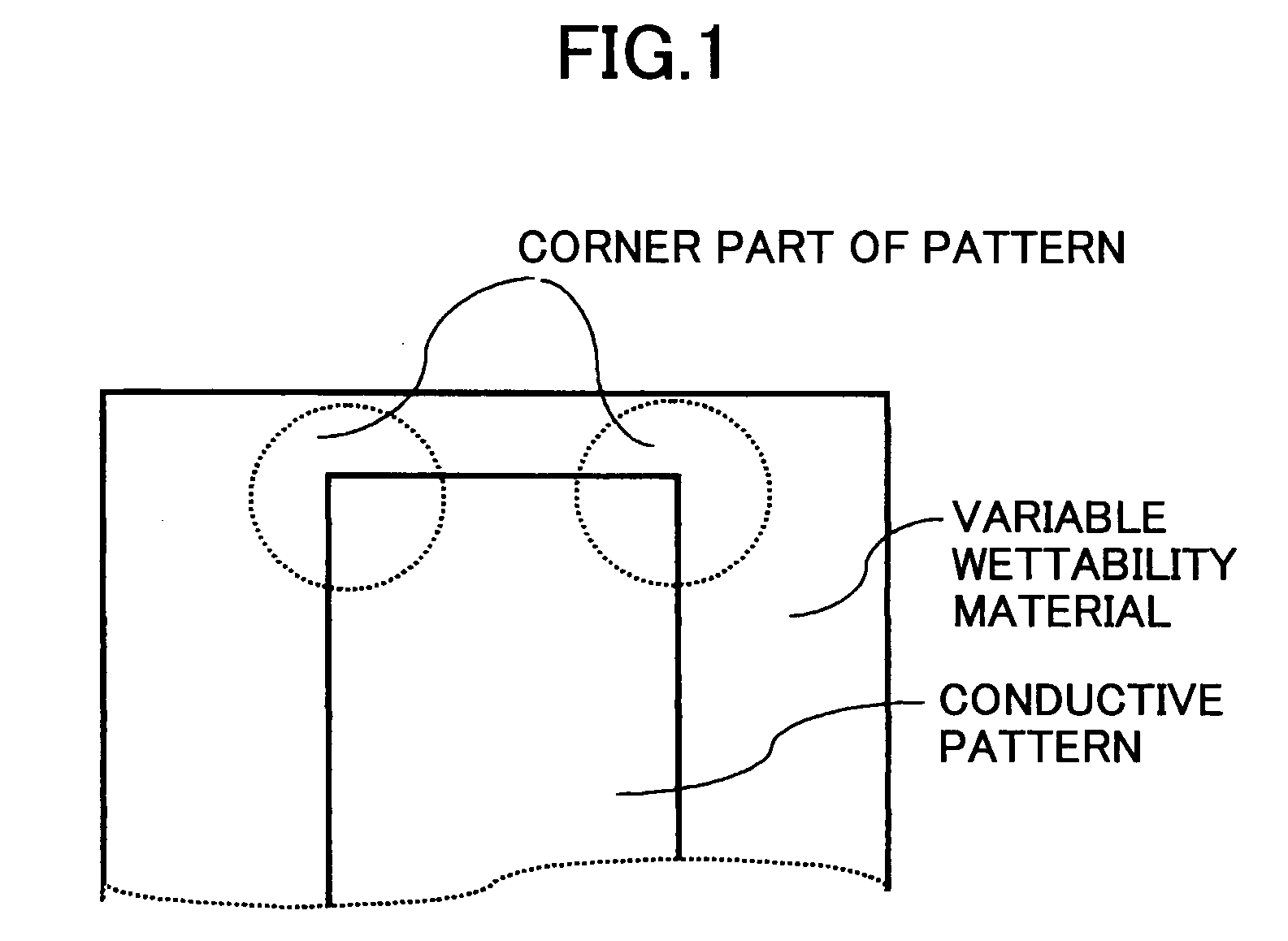Wiring pattern, electronic device, organic semiconductor device, layered wiring pattern, and layered wiring substrate using the wiring pattern
a technology of organic semiconductors and wiring patterns, applied in the direction of printed circuit manufacturing, printed circuit aspects, thermoelectric devices, etc., can solve the problems of increasing manufacturing costs, requiring expensive facilities, and affecting the effect of photolithography results
- Summary
- Abstract
- Description
- Claims
- Application Information
AI Technical Summary
Benefits of technology
Problems solved by technology
Method used
Image
Examples
example 1
[0144]A variable wettability layer (hereinafter also referred to as “wettability control film”) is formed by applying a mixed solution having dissolved therein a precursor of the materials having a structure expressed with the below Formulas 6 and 7 onto a glass substrate by using a spin-coating method and baking the mixed solution in an environment of 280° C.
[0145]Then, a wettability area (high surface energy part) is formed on the variable wettability layer by using a mask having a pattern (opening(s)). The pattern of the mask is chamfered in a manner shown in FIG. 7A and has a line width of 80 μm and a chamfer length of 20 μm. In measuring the contact angle of the wettability area by using a silver nanoparticle ink, the wettability area exhibited a contact angle that is no greater than 5°.
[0146]Then, a conductive liquid (in this example, silver nanoparticle ink) is applied to the wettability area by using an inkjet method. Then, the variable wettability layer on which the silver ...
example 2
[0150]In Example 2, an insulating film is formed on the conductive pattern described in Example 1 (hereinafter referred to as “first conductive pattern layer”) by spin-coating polyimide onto the first conductive pattern layer and baking the coated configuration. Then, a second wettability control film formed of the same material as the Example 1 is formed on the insulating film. The combined thickness of the polyimide insulating film and the second wettability control film is 500 nm. Then, a wettability pattern (second wettability area) is formed on the second wettability control film by arranging a mask at a predetermined position on the second wettability control film and irradiating UV rays thereto. The mask is positioned so that the pattern of the second wettability control film intersects (overlaps) with the first pattern layer. Then, a silver nanoparticle ink is applied to the second wettability area by using an inkjet method. Then, the wettability control film on which the si...
example 3
[0154]In Example 3, ten devices (in this example, thin film transistors (TFT)) having an electrode configuration shown in a plan view of FIG. 25B were fabricated under the below-described conditions.
[0155]First, as shown in FIG. 25A, a conductive pattern (gate electrode pattern) is formed by using the same material and method as those described in Example 1. The gate electrode pattern has a line width of 80 μm and a rounded chamfered part with a radius (R) of 40 μm. Then, a variable wettability layer (wettability control layer) is formed on the gate electrode pattern by spin-coating polyimide onto the gate electrode pattern and baking the coated configuration. Then, as shown in FIG. 25B, a source electrode pattern and a drain electrode pattern are formed on the variable wettability layer by arranging a mask at a predetermined position on the variable wettability layer and irradiating UV rays thereto.
[0156]Finally, a semiconductor layer is formed on the variable wettability layer by ...
PUM
 Login to View More
Login to View More Abstract
Description
Claims
Application Information
 Login to View More
Login to View More - R&D
- Intellectual Property
- Life Sciences
- Materials
- Tech Scout
- Unparalleled Data Quality
- Higher Quality Content
- 60% Fewer Hallucinations
Browse by: Latest US Patents, China's latest patents, Technical Efficacy Thesaurus, Application Domain, Technology Topic, Popular Technical Reports.
© 2025 PatSnap. All rights reserved.Legal|Privacy policy|Modern Slavery Act Transparency Statement|Sitemap|About US| Contact US: help@patsnap.com



